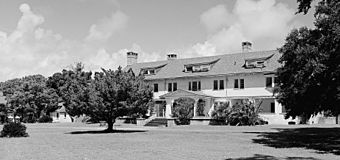Stafford Plantation facts for kids
Quick facts for kids |
|
|
Stafford Plantation Historic District
|
|

Stafford mansion
|
|
| Lua error in Module:Location_map at line 420: attempt to index field 'wikibase' (a nil value). | |
| Nearest city | St. Marys, Georgia |
|---|---|
| Built | 1901 |
| MPS | Cumberland Island National Seashore MRA |
| NRHP reference No. | 84000265 |
| Added to NRHP | November 23, 1984 |
The Stafford Plantation was a large farm or estate located on Cumberland Island in Camden County, Georgia, along the southeastern coast of Georgia. It was first started in the early 1800s by a man named Robert Stafford. Plantations like Stafford were a big part of the history of the southern United States.
Contents
The Story of Stafford Plantation
Starting Out: The 1800s
Robert Stafford began to buy land on Cumberland Island in the early 1800s. Some of this land had once belonged to General Nathanael Greene, a hero from the American Revolutionary War. By 1830, Robert Stafford owned about 1,360 acres of land. To work this large farm, he used a system of forced labor, where many enslaved people were made to work the fields.
In 1843, Stafford bought even more land, adding another 4,200 acres to his property. The main crop grown at Stafford Plantation was Sea Island Cotton, a special type of cotton known for its long, strong fibers.
Robert Stafford passed away in 1877. After his death, his family sold the plantation. The new owners were Thomas M. Carnegie and his wife Lucy. They also bought another famous property on the island called Dungeness.
Today, not much is left of Robert Stafford's original house. However, you can still see "the Chimneys." These are the remains of 24 hearth-and-chimney structures. They were once part of the homes where the enslaved people lived, about one kilometer east of the main house.
A New Era: The 1900s
The beautiful Stafford Mansion that stands today was built in 1901. Lucy Carnegie had it built for one of her children. The mansion was one of several grand homes that the Carnegie family built on Cumberland Island. Other Carnegie homes included Plum Orchard, Greyfield, and their main residence at Dungeness.
Stafford Plantation Today
Today, the Stafford Plantation property is still privately owned by a descendant of the Carnegie family. It is located within the Cumberland Island National Seashore, which is a protected area managed by the National Park Service. This means that while it's a private home, it's also part of a larger natural and historical park that visitors can explore.


